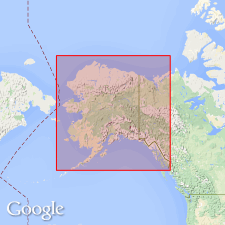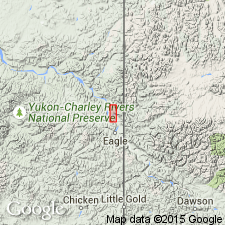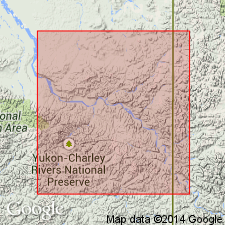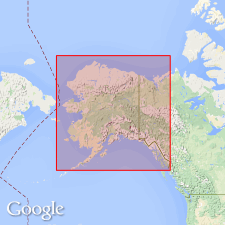
- Usage in publication:
-
- Calico Bluff formation*
- Modifications:
-
- Original reference
- Dominant lithology:
-
- Limestone
- Slate
- Shale
- AAPG geologic province:
-
- Alaska East-Central region
Summary:
Pg. 292, etc. Calico Bluff formation. Thin-bedded limestone, slates, and shales; some igneous rock. Invertebrate fossils of Early Carboniferous age. Conformably overlies Upper Devonian shales and slates. Underlies (unconformably) Nation River formation.
Exposed at Calico Bluff and other points on Upper Yukon River, also on Porcupine River, Nation River region, central eastern AK.
Source: US geologic names lexicon (USGS Bull. 896, p. 318).

- Usage in publication:
-
- Calico Bluff formation*
- Modifications:
-
- Age modified
- AAPG geologic province:
-
- Alaska East-Central region
Summary:
Pg. 423. Calico Bluff formation. Mertie stated that he believed a group of intermediate or transitional rocks, 1,000 to 2,000 feet thick exists between Nation River formation and Calico Bluff formation in Tatonduk-Nation district, but that this remains to be proved. He assigned Calico Bluff formation to upper Mississippian (Chester), on basis of fossils identified by G.H. Girty.
Source: US geologic names lexicon (USGS Bull. 896, p. 318).

- Usage in publication:
-
- Calico Bluff Formation*
- Modifications:
-
- Age modified
- AAPG geologic province:
-
- Alaska East-Central region
Summary:
At Calico Bluff on Yukon River, Calico Bluff Formation of Late Mississippian age conformably overlies Ford Lake Shale (new) of Late Devonian to Late Mississippian age, which in turn overlies Nation River Formation of Late Devonian age.
Source: GNU records (USGS DDS-6; Menlo GNULEX).

- Usage in publication:
-
- Calico Bluff Formation*
- Modifications:
-
- Age modified
- Biostratigraphic dating
- AAPG geologic province:
-
- Alaska East-Central region
Summary:
Pg. 54. Calico Bluff Formation. At type locality consists primarily of argillaceous brown-black shales and some beds of argillaceous lime mudstone to packstone; limestones and calcareous shales are more abundant in lower 200 to 300 feet of formation. Thickness 1,500+/- feet. Age is Late Mississippian to Early Pennsylvanian. Microfossils examined by B.L. Mamet indicate base is zone 16 (lower Chesterian) and top is zone 20 (Morrowan); continuous deposition.
Type locality: large cut bank [Calico Bluff] of Yukon River, east-central AK (see Brabb, 1969, figs. 2, 3).
Source: Publication.
For more information, please contact Nancy Stamm, Geologic Names Committee Secretary.
Asterisk (*) indicates published by U.S. Geological Survey authors.
"No current usage" (†) implies that a name has been abandoned or has fallen into disuse. Former usage and, if known, replacement name given in parentheses ( ).
Slash (/) indicates name conflicts with nomenclatural guidelines (CSN, 1933; ACSN, 1961, 1970; NACSN, 1983, 2005, 2021). May be explained within brackets ([ ]).

